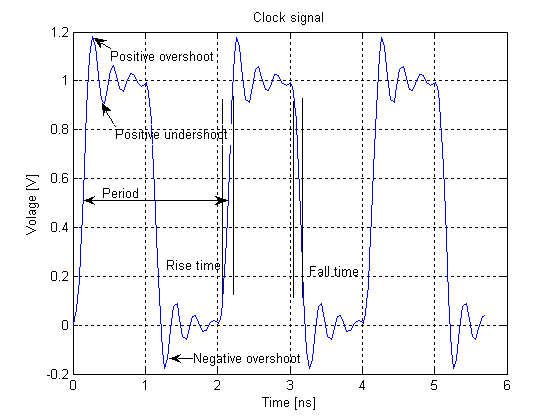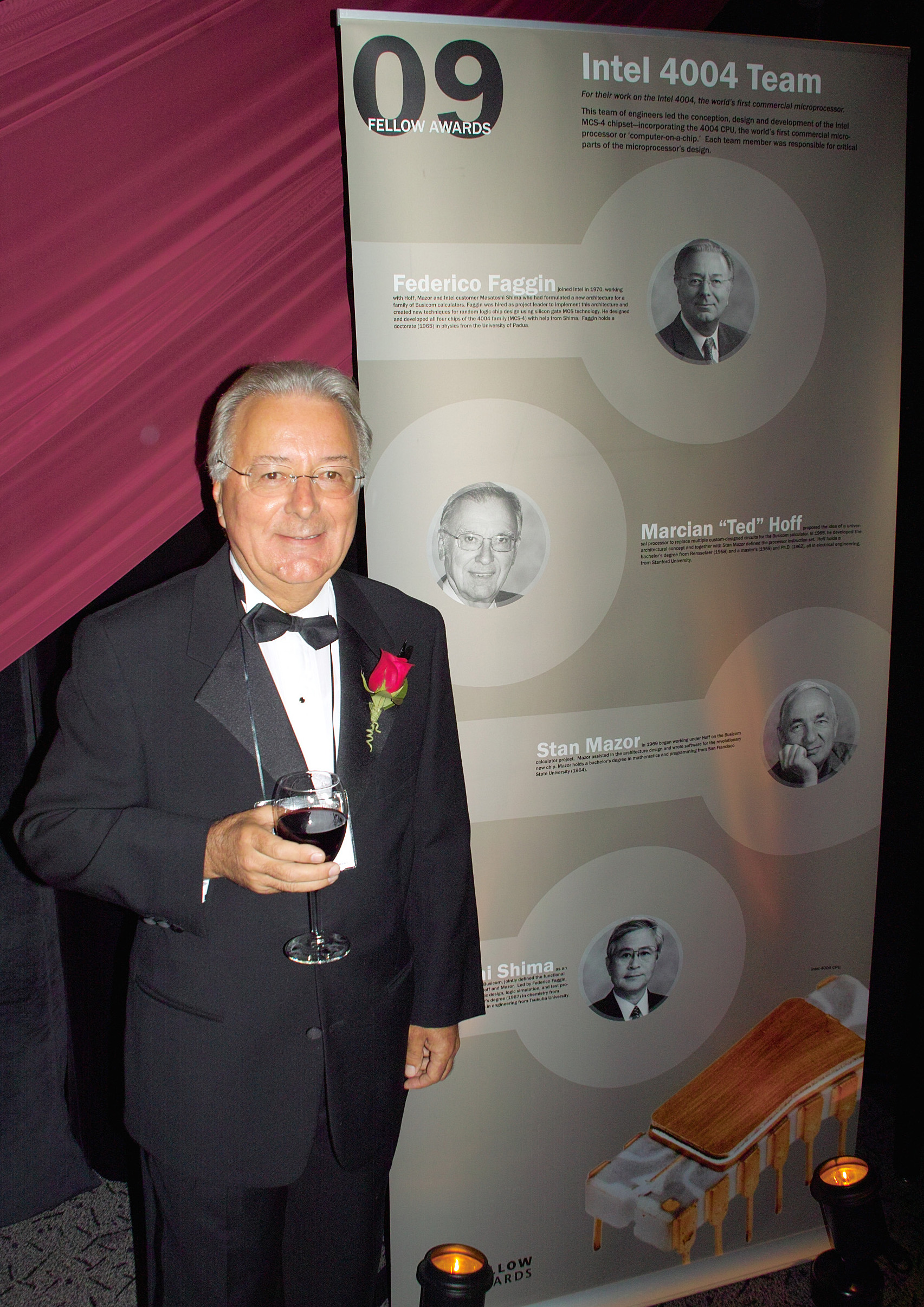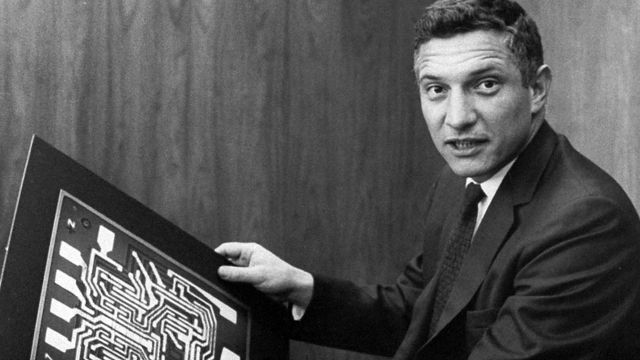|
μP
A microprocessor is a computer processor for which the data processing logic and control is included on a single integrated circuit (IC), or a small number of ICs. The microprocessor contains the arithmetic, logic, and control circuitry required to perform the functions of a computer's central processing unit (CPU). The IC is capable of interpreting and executing program instructions and performing arithmetic operations. The microprocessor is a multipurpose, clock-driven, register-based, digital integrated circuit that accepts binary data as input, processes it according to instructions stored in its memory, and provides results (also in binary form) as output. Microprocessors contain both combinational logic and sequential digital logic, and operate on numbers and symbols represented in the binary number system. The integration of a whole CPU onto a single or a few integrated circuits using Very-Large-Scale Integration (VLSI) greatly reduced the cost of processing powe ... [...More Info...] [...Related Items...] OR: [Wikipedia] [Google] [Baidu] |
Metal–oxide–semiconductor
upright=1.3, Two power MOSFETs in amperes">A in the ''on'' state, dissipating up to about 100 watt">W and controlling a load of over 2000 W. A matchstick is pictured for scale. In electronics, the metal–oxide–semiconductor field-effect transistor (MOSFET, MOS-FET, MOS FET, or MOS transistor) is a type of field-effect transistor (FET), most commonly fabricated by the controlled oxidation of silicon. It has an insulated gate, the voltage of which determines the conductivity of the device. This ability to change conductivity with the amount of applied voltage can be used for amplifying or switching electronic signals. The term ''metal–insulator–semiconductor field-effect transistor'' (''MISFET'') is almost synonymous with ''MOSFET''. Another near-synonym is ''insulated-gate field-effect transistor'' (''IGFET''). The main advantage of a MOSFET is that it requires almost no input current to control the load current under steady-state or low-frequency conditions, e ... [...More Info...] [...Related Items...] OR: [Wikipedia] [Google] [Baidu] |
Clock Signal
In electronics and especially synchronous digital circuits, a clock signal (historically also known as ''logic beat'') is an electronic logic signal (voltage or current) which oscillates between a high and a low state at a constant frequency and is used like a metronome to synchronize actions of digital circuits. In a synchronous logic circuit, the most common type of digital circuit, the clock signal is applied to all storage devices, flip-flops and latches, and causes them all to change state simultaneously, preventing race conditions. A clock signal is produced by an electronic oscillator called a clock generator. The most common clock signal is in the form of a square wave with a 50% duty cycle. Circuits using the clock signal for synchronization may become active at either the rising edge, falling edge, or, in the case of double data rate, both in the rising and in the falling edges of the clock cycle. Digital circuits Most integrated circuits (ICs) of suffi ... [...More Info...] [...Related Items...] OR: [Wikipedia] [Google] [Baidu] |
Binary Number
A binary number is a number expressed in the Radix, base-2 numeral system or binary numeral system, a method for representing numbers that uses only two symbols for the natural numbers: typically "0" (zero) and "1" (one). A ''binary number'' may also refer to a rational number that has a finite representation in the binary numeral system, that is, the quotient of an integer by a power of two. The base-2 numeral system is a positional notation with a radix of 2. Each digit is referred to as a bit, or binary digit. Because of its straightforward implementation in digital electronic circuitry using logic gates, the binary system is used by almost all modern computer, computers and computer-based devices, as a preferred system of use, over various other human techniques of communication, because of the simplicity of the language and the noise immunity in physical implementation. History The modern binary number system was studied in Europe in the 16th and 17th centuries by Thoma ... [...More Info...] [...Related Items...] OR: [Wikipedia] [Google] [Baidu] |
Federico Faggin
Federico Faggin (, ; born 1 December 1941) is an Italian-American physicist, engineer, inventor and entrepreneur. He is best known for designing the first commercial microprocessor, the Intel 4004. He led the 4004 (MCS-4) project and the design group during the first five years of Intel's microprocessor effort. Faggin also created, while working at Fairchild Semiconductor in 1968, the self-aligned MOS ( metal–oxide–semiconductor) silicon-gate technology (SGT), which made possible MOS semiconductor memory chips, CCD image sensors, and the microprocessor. After the 4004, he led development of the Intel 8008 and 8080, using his SGT methodology for random logic chip design, which was essential to the creation of early Intel microprocessors. He was co-founder (with Ralph Ungermann) and CEO of Zilog, the first company solely dedicated to microprocessors, and led the development of the Zilog Z80 and Z8 processors. He was later the co-founder and CEO of Cygnet Technologies ... [...More Info...] [...Related Items...] OR: [Wikipedia] [Google] [Baidu] |
Intel 4004
The Intel 4004 was part of the 4 chip MCS-4 micro computer set, released by the Intel, Intel Corporation in November 1971; the 4004 being part of the first commercially marketed microprocessor chipset, and the first in a long line of List of Intel processors, Intel central processing units (CPUs). Priced at , the chip marked both a technological and economic milestone in computing. The 4-bit computing, 4-bit 4004 CPU was the first significant commercial example of large-scale integration, showcasing the abilities of the Self-aligned gate, MOS silicon gate technology (SGT). Compared to the existing technology, SGT enabled twice the transistor density and five times the operating speed, making future single-chip CPUs feasible. The MCS-4 chip set design served as a model on how to use SGT for complex logic and memory circuits, accelerating the adoption of SGT by the world's semiconductor industry. The project originated in 1969 when Busicom, Busicom Corp. commissioned Intel to de ... [...More Info...] [...Related Items...] OR: [Wikipedia] [Google] [Baidu] |
Large-scale Integration
An integrated circuit (IC), also known as a microchip or simply chip, is a set of electronic circuits, consisting of various electronic components (such as transistors, resistors, and capacitors) and their interconnections. These components are etched onto a small, flat piece ("chip") of semiconductor material, usually silicon. Integrated circuits are used in a wide range of electronic devices, including computers, smartphones, and televisions, to perform various functions such as processing and storing information. They have greatly impacted the field of electronics by enabling device miniaturization and enhanced functionality. Integrated circuits are orders of magnitude smaller, faster, and less expensive than those constructed of discrete components, allowing a large transistor count. The IC's mass production capability, reliability, and building-block approach to integrated circuit design have ensured the rapid adoption of standardized ICs in place of designs using discre ... [...More Info...] [...Related Items...] OR: [Wikipedia] [Google] [Baidu] |
Transistor–transistor Logic
Transistor–transistor logic (TTL) is a logic family built from bipolar junction transistors (BJTs). Its name signifies that transistors perform both the logic function (the first "transistor") and the amplifying function (the second "transistor"), as opposed to earlier resistor–transistor logic (RTL) and diode–transistor logic (DTL). TTL integrated circuits (ICs) were widely used in applications such as computers, industrial controls, test equipment and instrumentation, consumer electronics, and synthesizers. After their introduction in integrated circuit form in 1963 by Sylvania Electric Products, TTL integrated circuits were manufactured by several semiconductor companies. The 7400 series by Texas Instruments became particularly popular. TTL manufacturers offered a wide range of logic gates, flip-flops, counters, and other circuits. Variations of the original TTL circuit design offered higher speed or lower power dissipation to allow design optimization. TTL devices w ... [...More Info...] [...Related Items...] OR: [Wikipedia] [Google] [Baidu] |
Small-scale Integration
An integrated circuit (IC), also known as a microchip or simply chip, is a set of electronic circuits, consisting of various electronic components (such as transistors, resistors, and capacitors) and their interconnections. These components are etched onto a small, flat piece ("chip") of semiconductor material, usually silicon. Integrated circuits are used in a wide range of electronic devices, including computers, smartphones, and televisions, to perform various functions such as processing and storing information. They have greatly impacted the field of electronics by enabling device miniaturization and enhanced functionality. Integrated circuits are orders of magnitude smaller, faster, and less expensive than those constructed of discrete components, allowing a large transistor count. The IC's mass production capability, reliability, and building-block approach to integrated circuit design have ensured the rapid adoption of standardized ICs in place of designs using disc ... [...More Info...] [...Related Items...] OR: [Wikipedia] [Google] [Baidu] |
Medium-scale Integration
An integrated circuit (IC), also known as a microchip or simply chip, is a set of electronic circuits, consisting of various electronic components (such as transistors, resistors, and capacitors) and their interconnections. These components are etched onto a small, flat piece ("chip") of semiconductor material, usually silicon. Integrated circuits are used in a wide range of electronic devices, including computers, smartphones, and televisions, to perform various functions such as processing and storing information. They have greatly impacted the field of electronics by enabling device miniaturization and enhanced functionality. Integrated circuits are orders of magnitude smaller, faster, and less expensive than those constructed of discrete components, allowing a large transistor count. The IC's mass production capability, reliability, and building-block approach to integrated circuit design have ensured the rapid adoption of standardized ICs in place of designs using dis ... [...More Info...] [...Related Items...] OR: [Wikipedia] [Google] [Baidu] |
Circuit Board
A printed circuit board (PCB), also called printed wiring board (PWB), is a laminated sandwich structure of conductive and insulating layers, each with a pattern of traces, planes and other features (similar to wires on a flat surface) etched from one or more sheet layers of copper laminated onto or between sheet layers of a non-conductive substrate. PCBs are used to connect or "wire" components to one another in an electronic circuit. Electrical components may be fixed to conductive pads on the outer layers, generally by soldering, which both electrically connects and mechanically fastens the components to the board. Another manufacturing process adds vias, metal-lined drilled holes that enable electrical interconnections between conductive layers, to boards with more than a single side. Printed circuit boards are used in nearly all electronic products today. Alternatives to PCBs include wire wrap and point-to-point construction, both once popular but now rarely ... [...More Info...] [...Related Items...] OR: [Wikipedia] [Google] [Baidu] |
Rock's Law
Rock's law or Moore's second law, named for Arthur Rock or Gordon Moore, says that the cost of a semiconductor chip fabrication plant doubles every four years. As of 2015, the price had reached about 14 billion US dollars. Rock's law can be seen as the economic flip side to Moore's (first) law – that the number of transistors in a dense integrated circuit doubles every two years. The latter is a direct consequence of the ongoing growth of the capital-intensive semiconductor industry— innovative and popular products mean more profits, meaning more capital available to invest in ever higher levels of large-scale integration, which in turn leads to the creation of even more innovative products. The semiconductor industry has always been extremely capital-intensive, with ever-dropping manufacturing unit costs. Thus, the ultimate limits to growth of the industry will constrain the maximum amount of capital that can be invested in new products; at some point, Rock's Law will co ... [...More Info...] [...Related Items...] OR: [Wikipedia] [Google] [Baidu] |







